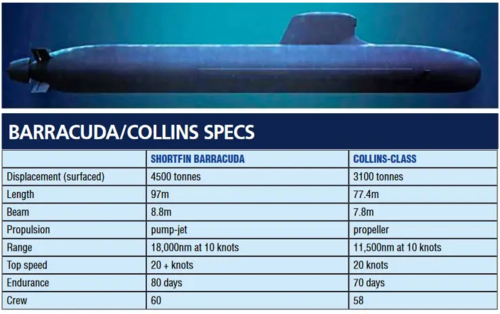Wow, I can't tell you how much this video depresses me - not the actual video or the narrator, but the fact that this whole important submarine program is obviously more to do with "business" and Australia's own little dirty 'Military/Political Complex' rather than a true fighting vessel for the RAN.
Peter Costello and old mate of Scomo - David Gazard WTF!!!
I truly can't believe after the hard learnt lessons from building the
Collins class and the in-depth nature and intent of the
Coles Review, we as a nation, as a government and as a Navy could f#@% up this second bite of the cherry!!
I'm now adimit that Australian has lost it's right to build submarines in Australia and that the
Collins class should be replaced by an off-the-shelf design, tailored for the RAN's needs.!!!
Regards
Pioneer
Japanese and German options were found not to meet the stated requirements, legacy design features in each (both were the result of continuous evolution over decades) made them less advanced in many ways than the existing Collins Class (which was a clean sheet design from the late 80s early 90s), and more importantly, than the French offering.
I barely know where to begin here. The
Collins is an enlarged evolution of
Västergötland, with far greater range and completely different combat sytem, and that class is itself an evolution of the earlier
Näcken class. It was never a clean-sheet design, or anything like it. The current state of the
Collins, which has made a quite proud class out of some pretty questionable early decisions, isn't due to any inherent "advanced" design so much as a multi-national effort to turn them into the effective boats they are today. The idea that
Sōryū is "less advanced" than
Collins in basic design is fairly silly.
Soryu is an evolution of Barbel, a 1950s US design. According to my contacts, i.e. people still working on subs, they lack the fully rafted design of Collins and include many legacy features that have been superseded in Collins.
Claiming the Collins is simply an enlarged evolution of the Vastergotland is like saying the Boeing 787 is an enlarged evolution of the 737 because they have similar configurations and come from the same designer. The Collins and Gotland have far more features in common and are more closely related as they were designed by the same team at the same time, it is understood in the game that the Collins contract gave Sweden the money they required to design the Gotland. That said, scaling up the Vastergotland is what was sold to the political classes but the issues encountered with the Collins development and build demonstrate just how inaccurate this was.
An example of the fundamental differences can be seen in the welding issues found in the Swedish fabricated sections for the first hull, the design and fabrication techniques required were so different that the highly experienced Swedish sub builders delivered dangerously substandard sections that had to be completely reworked during the first full cycle docking. Ironically the new Australian workforce, which due to its inexperience worked within a much more highly controlled environment as a mitigation to their inexperience, delivered conforming product. Had it been a simple evolution the experienced Kockums fabricators would have had no problems and actually had no issues building the related Gotlands.
The riskiest path forward is scaling up and down a design. By all means pick and use improved and evolved systems in a new hull, if you have a MOTS solution for the hull that meets requirements then go for that, but if you don't you are better off with a clean sheet for the platform. Anything else is a complex and risky compromise with many unforeseen consequences, as proved by the Collins build.
What you have fallen into is the political narrative that a broken design was fixed, rather than the truth known to everyone who has ever worked on a major project, there will always be development issues that need to be addressed, no matter who the designer or who the builder is. In the middle of a review into another project I worked the designer / builder of the product we were building under licence was caught out when we discovered and proved that they had encountered the exact same issue we had during their build, the thing is they had lied to our customer and told them that it was our incompetence and not their design at fault.
That is the Collins project in a nutshell and the same is happening with the Attack, there are issues that occur on every project that are happening on this one but the narrative, depending on your bias is either Aussies can't build submarines, the French are bullies, should have gone Astute/Virginia/Soryu/Type 214/6 etc.








